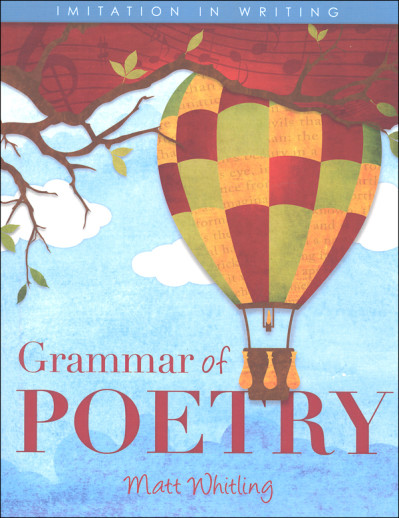We use cookies to make your experience better. To comply with the new e-Privacy directive, we need to ask for your consent to set the cookies. Learn more.
Grammar of Poetry
An excellent resource, this book teaches students to write poetry by studying the forms and styles of great writers such as Shakespeare, Scott, Tennyson, and Longfellow. Students then complete a number of practice activities which reinforce the concepts learned.
The student workbook contains 30 lessons. It is recommended that three lessons be covered each week. Each lesson takes approximately 30 minutes to complete.
As the teacher you will likely want to read through the new concepts at the top of the page with your student. Concepts covered in this volume include: simile, rhyme, how to use a rhyming dictionary, metaphor, meter, pun, iamb, personification, trochee, synecdoche, anapest, hyperbole, dactyl, onomatopoeia, alliteration, rhetorical question, refrain, oxymoron, spacial poetry, and euphemism. The student will then work through the activity. After every few lessons, review questions are given to insure that the concepts are retained and to provide additional practice of previously-covered information. Upon the completion of this program, the student should have mastered several figures of speech called tropes. A cumulative test is also included. Teacher's edition contains teaching instructions as well as completed student pages. ~ Rachel
This is the ideal introductory text for students and teachers discovering the art of poetry. As a 'grammar,' it teaches the fundamentals of poetry from scansion and rhyme to more advanced concepts like spatial poetry and synecdoche.
Using the classical methodology of imitation (advocated by educators like Quintilian and Benjamin Franklin), this text makes students become active participants as they learn the craft of writing poems. It also offers practical tips and helps, including how to use a rhyming dictionary, how great writers use figures of speech effectively, and even when to break the rules of poetry. Its goal is to show students how to capably interact not just with poems, but with language in any situation.
Developed and used at Logos School with great success, the thirty lessons in Grammar of Poetry contain instruction on ten powerful tropes, student activities for every chapter, riddles to solve, a glossary of terms, a list of over 150 quality poems to integrate, and real-life examples from Shakespeare to traditional tongue twisters. It is designed for a semester at the 6-9th grade level, but is perfectly appropriate for anyone with basic writing skills and the desire to learn poetry.
These materials cover various types of creative writing, including descriptive writing, poetry, journaling, and stories.
These materials include both writing instruction and writingassignments.
This course teaches students to write poetry by studying the forms and styles of great writers such as Shakespeare, Scott, Tennyson, and Longfellow. Students then complete a number of practice activities which reinforce the concepts learned. The student workbook contains 30 lessons. It is recommended that three lessons be covered each week. Each lesson takes approximately 30 minutes to complete.
As the teacher you will likely want to read through the new concepts at the top of the page with your student. Concepts covered in this volume include: simile, rhyme, how to use a rhyming dictionary, metaphor, meter, pun, iamb, personification, trochee, synecdoche, anapest, hyperbole, dactyl, onomatopoeia, alliteration, rhetorical question, refrain, oxymoron, spacial poetry, and euphemism. The student will then work through the activity. After every few lessons, review questions are given to insure that the concepts are retained and to provide additional practice of previously-covered information. Upon the completion of this program, the student should have mastered several figures of speech called tropes. Teacher's edition contains teaching instructions as well as completed student pages. ~ Rachel
| Product Format: | Softcover Book |
|---|---|
| Brand: | Logos School Materials |
| Author: | Matt Whitling |
| Grades: | 5-12 |
| ISBN: | 9781591281191 |
| Length in Inches: | 10.75 |
| Width in Inches: | 8.5 |
| Height in Inches: | 0.5 |
| Weight in Pounds: | 0.9625 |

